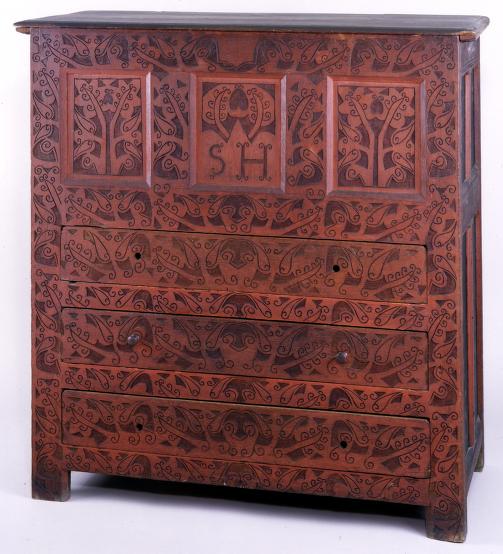|

(c) Pocumtuck Valley Memorial Association, Deerfield MA. All rights reserved.
Customs : Possessions Reveal Social Standing
|
|
What people made, purchased and displayed in their homes in this period conveyed information about social standing as well as wealth. The eighteenth-century philosopher Montesquieu expressed the economic theory of the age when he wrote, "If the rich do not spend so lavishly, the poor would die." The wealthier members of a community were supposed to support the economy by spending and displaying their wealth. The job of the poor was to produce, not to spend. Even the clothes a person wore were supposed to indicate his or her place in the social order. Early sumptuary laws punished people who conveyed confusing signals about their status by wearing clothes too fine for their "station" in life.
These economic and social assumptions accompanied early European settlers to North America. England, for example, encouraged its colonists to support the economy of the nation by importing English-made textiles, ceramics and other finished goods. Colonists also produced items to trade within the colonies or in their own communities. A Connecticut River Valley joiner made this chest for Sarah Hawks (1701-1783) of Deerfield, Massachusetts. Its abstract tulip and leaf pattern is typical of chests produced in this region from 1680-1740 in workshops from Enfield, Connecticut, to Northfield, Massachusetts. Sarah probably received this chest upon marrying Thomas Wells in 1726. At a time when most houses lacked closets, people used chests to store linens, clothing and other valuable textiles. Sarah's chest set her and her family apart from those who could not afford such a piece of furniture or the textiles it stored. At the same time, people considered this locally made piece less stylish and valuable in its time than an imported English-made chest.
top of page
|
"SH" joined chest
| creator Unidentified |
| date c. 1710 |
| location Connecticut River Valley |
| width 44.25" |
| depth 18.5" |
| height 45.5" |
| process/materials oak |
| item type Household Goods/Furniture |
| accession # #BR.49 |
|





